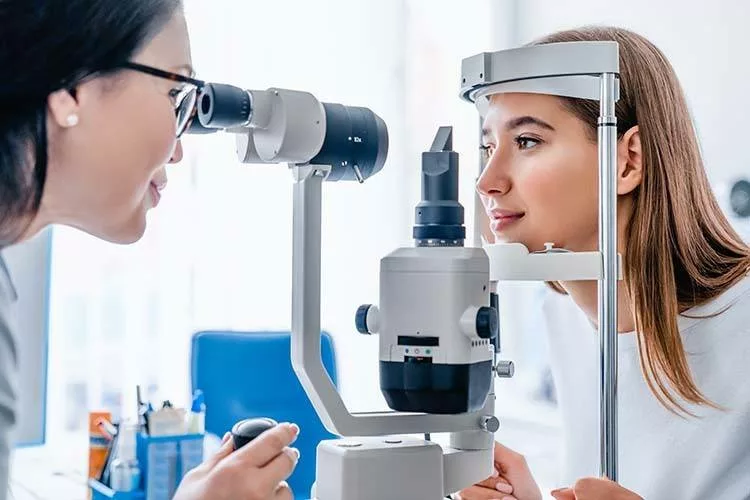Recognizing the Function of Your Eye Doctor in Keeping Vision
Exploring the Most Recent Technical Improvements in Optometry and What They Mean for Eye Doctors
From the accuracy of Optical Comprehensibility Tomography to the nuanced insights supplied by AI-driven analysis devices, these innovations are establishing brand-new criteria in patient evaluation and treatment. As these developments permeate the method, optometrists are encountered with the obstacle of embracing these devices to boost patient outcomes.
Developments in Diagnostic Tools
Advancing the field of optometry, technologies in analysis devices have transformed the means eye treatment specialists analyze and diagnose ocular conditions and aesthetic problems. The previous years has seen substantial technical innovations, allowing even more thorough and precise analyses. Optical Comprehensibility Tomography (OCT), as an example, offers high-resolution cross-sectional pictures of the retina, enabling the early discovery of diseases such as glaucoma and age-related macular deterioration. This non-invasive imaging technique has come to be crucial in modern optometric technique.
An additional secret technology is the intro of innovative corneal topography systems, which map the surface area curvature of the cornea with accuracy. These tools are especially helpful for fitting get in touch with lenses and diagnosing corneal conditions. Electronic retinal imaging has changed standard ophthalmoscopy, supplying detailed, scenic views of the retina that facilitate thorough visual evaluations.
The development of wavefront aberrometry has actually also been important, making it possible for the analysis of refractive errors with unrivaled accuracy (Eye Doctor Optometrist). This technology helps in customizing rehabilitative lenses and improving medical end results for refractive surgical procedures. Jointly, these diagnostic developments equip eye doctors to supply exceptional client care, making sure early intervention and tailored treatment strategies, ultimately enhancing aesthetic wellness outcomes
AI in Individual Administration
Building on the foundation of innovative analysis tools, the consolidation of artificial knowledge (AI) in person monitoring stands for a transformative jump for optometry. AI systems are significantly utilized to enhance effectiveness, precision, and customization in person treatment. By examining substantial amounts of information, AI can identify patterns and forecast prospective eye conditions, enabling eye doctors to tailor treatments much more effectively. This capability is critical in managing chronic eye diseases such as glaucoma and diabetic retinopathy, where very early detection and continuous surveillance are crucial.
Furthermore, AI-driven platforms help with streamlined client interactions and administrative processes. Automated organizing, digital consultations, and individualized follow-up plans not just enhance patient complete satisfaction but likewise optimize time management for specialists. These systems can triage clients based upon the necessity of their problems, making certain that those in crucial demand get punctual interest.
Moreover, AI improves decision-making by providing eye doctors with evidence-based suggestions and therapy pathways. By integrating data from digital health documents, AI devices provide insights that educate medical choices, minimizing the danger of mistakes and enhancing person results. As AI remains to develop, its duty in client management will likely increase, improving the landscape of optometric treatment.
Advancements in Retinal Imaging
In the world of optometry, retinal imaging has seen impressive technological improvements that are enhancing diagnostic capacities and patient treatment. Technologies such as Optical Coherence Tomography (OCT) and fundus photography have revolutionized just how eye doctors envision and analyze the retina.
Boosted imaging techniques like OCT angiography are further refining diagnostic precision. This non-invasive strategy maps blood flow in the retina, supplying crucial understandings into vascular health without the requirement for color injections. Furthermore, adaptive optics technology is being incorporated right into retinal imaging systems to correct ocular aberrations, supplying unmatched picture clearness. Such innovations help with the recognition of min retinal changes that might symbolize condition development.
Additionally, innovations in expert system are augmenting retinal imaging by enabling automatic evaluation of huge datasets. These systems assist optometrists in determining patterns a sign of pathology, thereby enhancing diagnostic accuracy and efficiency. Collectively, these developments are changing retinal imaging into a foundation of contemporary eye treatment, boosting end results and expanding therapeutic possibilities.
Teleoptometry's Growing Function
Teleoptometry is significantly ending up being an important component you can check here of eye treatment, driven by improvements in digital communication and diagnostic tools. This is specifically valuable in country and underserved areas where accessibility to specialized eye care is often limited.
The assimilation of expert system (AI) more improves teleoptometry, allowing the evaluation of visual data and aiding in the detection of ocular conditions such as glaucoma and diabetic person retinopathy. AI-powered formulas can quickly interpret intricate imaging data, providing eye doctors with important understandings that strengthen scientific decision-making.
Furthermore, teleoptometry sustains continuity of treatment through smooth assimilation with electronic wellness records (EHRs), permitting optometrists to preserve comprehensive individual histories. When consulting with different experts., this guarantees that people receive constant and personalized care also.
Despite these benefits, challenges remain, consisting of making sure data safety and security and handling patient expectations. Nevertheless, teleoptometry represents a significant stride in the direction of more accessible, efficient, and patient-centered eye care. As innovation develops, its duty is poised to expand even more.

Future Fads in Eye Treatment
A myriad of ingenious patterns is readied to improve the future of eye care, driven by technical developments and the progressing requirements of people. One considerable fad is the integration of man-made intelligence (AI) in diagnostics, which assures to improve the precision and efficiency of eye examinations. AI algorithms can analyze vast quantities of data from retinal images, possibly spotting problems like diabetic person retinopathy and glaucoma earlier than conventional techniques.
Moreover, customized medication is obtaining traction in optometry, with genetic testing notifying tailored treatment plans. This approach aims to optimize individual results by customizing interventions to private genetic profiles. Wearable innovation, such as wise contact lenses, is likewise imminent, supplying real-time surveillance of intraocular stress or sugar degrees, therefore offering continual insights right into eye and systemic health and wellness.
The adoption of increased reality (AR) and online truth (VIRTUAL REALITY) in training and patient education is another arising pattern. These technologies use immersive experiences that can boost understanding and skills both for optometrists and clients. As these fads progress, optometrists need to stay abreast of technical improvements to supply innovative care, ensuring better person outcomes and complete satisfaction in the dynamic landscape of eye treatment.
Conclusion
Collectively, these analysis advancements empower optometrists to deliver premium person treatment, guaranteeing early treatment and customized therapy strategies, inevitably improving visual health outcomes.

As these technologies continue to evolve, optometrists must adapt and include them right into technique, ultimately enhancing operations performance and raising the requirement of eye care delivered to people.